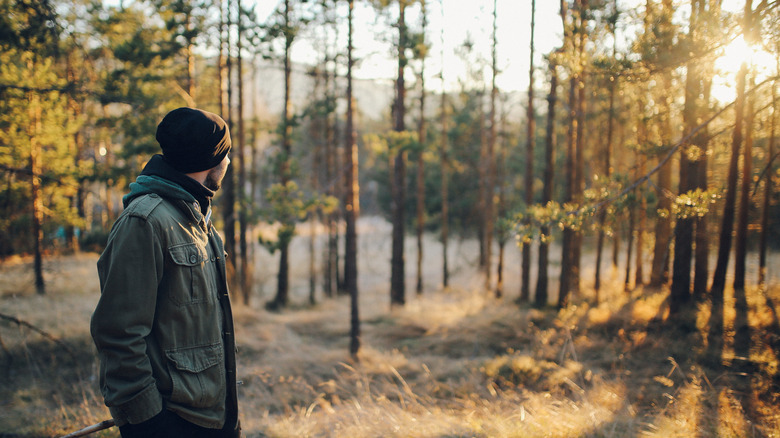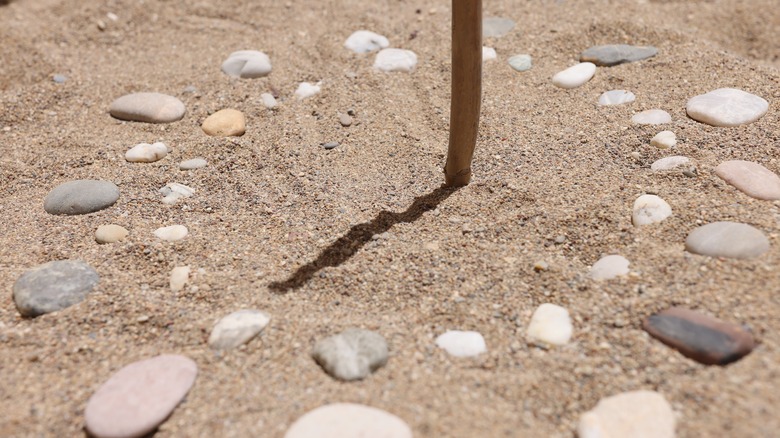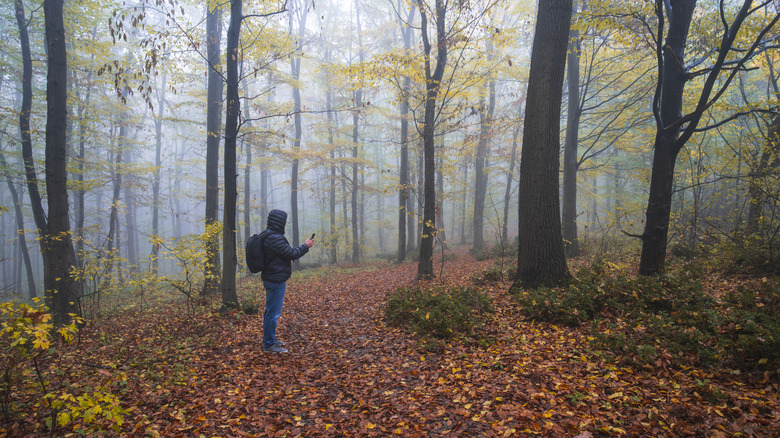Can You Use The Sun To Find Your Way If You Get Lost In The Woods?
Everyone gets lost sometimes. According to experimental psychologist Colin Ellard in an interview with NPR, humans, despite our advanced brains, fundamentally have a poor sense of direction compared to other animals. A mouse can be put in a light-proof box, turned around multiple times, and then put in a different spot and find its way back to where it started. A human can get lost in a brightly lit airport. So how can we navigate the wilderness and explore new places?
In the past, people relied on celestial navigation, or figuring out their position based on things we can see above us. The sun, as the most obvious thing in the sky, is the easiest choice. Incredibly, the sun was once used to chart exploratory voyages across vast oceans. Some, like Lehua Kamalu of the Polynesian Voyaging Society, are still able to navigate the seas without GPS, maps, or compasses. According to Travel + Leisure, Kamalu was able to navigate a 2,400 mile voyage using traditional wayfinding techniques that go back thousands of years — but does that mean you can find your way out of the woods by looking at the sky?
For most people, the sun is not the best tool for finding their way out of the woods. If the foliage is dense, the weather is bad, or it's getting dark, it may be difficult to accurately determine the sun's position, let alone your own. With the right preparation, however, the sun can be a useful navigational tool.
You can use the sun to make sure your path is straight
If you are lost in the woods, one of the most important things you can do is prevent yourself from getting even more lost. The sun can help. This method can't assure that you're going in the right direction — but it can help you keep going in the same direction.
First, you face the direction that you plan to walk and take note of where the sun is. If the sun is in front of you, you can hold your arm out straight towards the sun, taking note of what orientation you are to it. If the sun is behind you, you can hold your arm parallel to your shadow on the ground instead (but this will be tricky in the woods where other things also cast shadows). As you walk forward, you should ensure that the sun stays at that same angle to you. This has to be repeated every 10 minutes, as the earth rotates beneath you and the sun moves across the sky.
Using the sun instead of a compass
Without a compass to tell you which direction you are going, it can be hard to know where to begin navigating a route out of the wilderness. One method uses the sun to determine the direction.
On a bright sunny day, you can stick a branch into the ground and inspect its shadow. Mark the tip of where the shadow is cast by scratching the dirt or placing a small stone. In about 15 minutes, the shadow will have moved. Mark the new tip. The line between these points is a rough East-West line. If the second point (West) is to your left, then North is ahead of you. In the woods or on a cloudy day, this will be harder. If you are North of 60 degrees latitude, like in Alaska, however, this method won't be helpful.
It is possible to take a more accurate bearing for navigation using a sun timetable (which can be calculated for any location using the US Navy's Astronomical Applications Department website) and your watch. If you imagine that 12 o'clock is North or 0° and each hour is another 30°, then you can use the sun's location and the sun timetable to point yourself in the right direction. This method can be tricky, however, and requires that you have access to a sun timetable for the area you are lost.
Be prepared and stay calm
The sun can be a valuable tool for navigation, but you shouldn't rely on it to get you home if something goes wrong on your hike through the woods. The best thing you can do is be prepared.
Even if you plan to use GPS to navigate, bring a compass and study a physical map of the area before you set out. According to a study by SmokyMountains.com, the #1 reason that hikers get lost is leaving the trail, either on purpose or by accident. This can happen to experienced hikers when the trail seems to have two equally traveled paths, but one is just a social trail or a water bar. If you plan to go off-trail, you should have a bailout direction, or a way to get to a trail, road, or other easy to navigate feature, planned ahead of time. It's also vital to tell at least one person who is not coming on your hike where you will be going, in case you don't come back when expected.
If you become lost, stay calm. Look for landmarks and try to determine where you are. If you're on a trail, stay on it. If not, try following a downhill stream. If it's close to nightfall, you may want to hunker down and wait for morning to avoid becoming more lost in the dark. Make sure to eat, drink, and rest as you make your way out of the woods.



